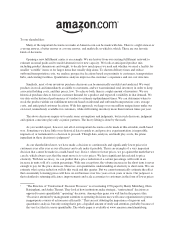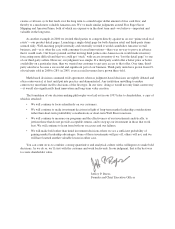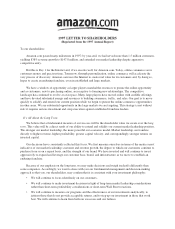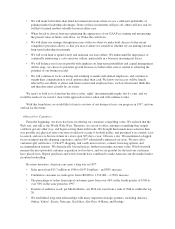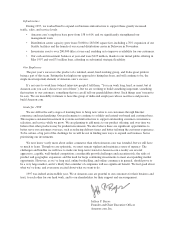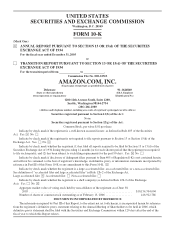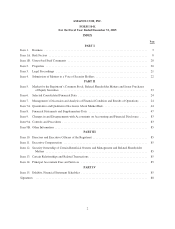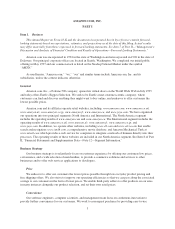Amazon.com 2005 Annual Report Download - page 3
Download and view the complete annual report
Please find page 3 of the 2005 Amazon.com annual report below. You can navigate through the pages in the report by either clicking on the pages listed below, or by using the keyword search tool below to find specific information within the annual report.
To our shareholders:
Many of the important decisions we make at Amazon.com can be made with data. There is a right answer or
a wrong answer, a better answer or a worse answer, and math tells us which is which. These are our favorite
kinds of decisions.
Opening a new fulfillment center is an example. We use history from our existing fulfillment network to
estimate seasonal peaks and to model alternatives for new capacity. We look at anticipated product mix,
including product dimensions and weight, to decide how much space we need and whether we need a facility for
smaller “sortable” items or for larger items that usually ship alone. To shorten delivery times and reduce
outbound transportation costs, we analyze prospective locations based on proximity to customers, transportation
hubs, and existing facilities. Quantitative analysis improves the customer’s experience and our cost structure.
Similarly, most of our inventory purchase decisions can be numerically modeled and analyzed. We want
products in stock and immediately available to customers, and we want minimal total inventory in order to keep
associated holding costs, and thus prices, low. To achieve both, there is a right amount of inventory. We use
historical purchase data to forecast customer demand for a product and expected variability in that demand. We
use data on the historical performance of vendors to estimate replenishment times. We can determine where to
stock the product within our fulfillment network based on inbound and outbound transportation costs, storage
costs, and anticipated customer locations. With this approach, we keep over one million unique items under our
own roof, immediately available for customers, while still turning inventory more than fourteen times per year.
The above decisions require us to make some assumptions and judgments, but in such decisions, judgment
and opinion come into play only as junior partners. The heavy lifting is done by the math.
As you would expect, however, not all of our important decisions can be made in this enviable, math-based
way. Sometimes we have little or no historical data to guide us and proactive experimentation is impossible,
impractical, or tantamount to a decision to proceed. Though data, analysis, and math play a role, the prime
ingredient in these decisions is judgment.1
As our shareholders know, we have made a decision to continuously and significantly lower prices for
customers year after year as our efficiency and scale make it possible. This is an example of a very important
decision that cannot be made in a math-based way. In fact, when we lower prices, we go against the math that we
can do, which always says that the smart move is to raise prices. We have significant data related to price
elasticity. With fair accuracy, we can predict that a price reduction of a certain percentage will result in an
increase in units sold of a certain percentage. With rare exceptions, the volume increase in the short term is never
enough to pay for the price decrease. However, our quantitative understanding of elasticity is short-term. We can
estimate what a price reduction will do this week and this quarter. But we cannot numerically estimate the effect
that consistently lowering prices will have on our business over five years or ten years or more. Our judgment is
that relentlessly returning efficiency improvements and scale economies to customers in the form of lower prices
1“The Structure of ‘Unstructured’ Decision Processes” is a fascinating 1976 paper by Henry Mintzberg, Duru
Raisinghani, and Andre Theoret. They look at how institutions make strategic, “unstructured” decisions as
opposed to more quantifiable “operating” decisions. Among other gems you will find in the paper is this:
“Excessive attention by management scientists to operating decisions may well cause organizations to pursue
inappropriate courses of action more efficiently.” They are not debating the importance of rigorous and
quantitative analysis, but only noting that it gets a lopsided amount of study and attention, probably because of
the very fact that it is more quantifiable. The whole paper is available at www.amazon.com/ir/mintzberg.



